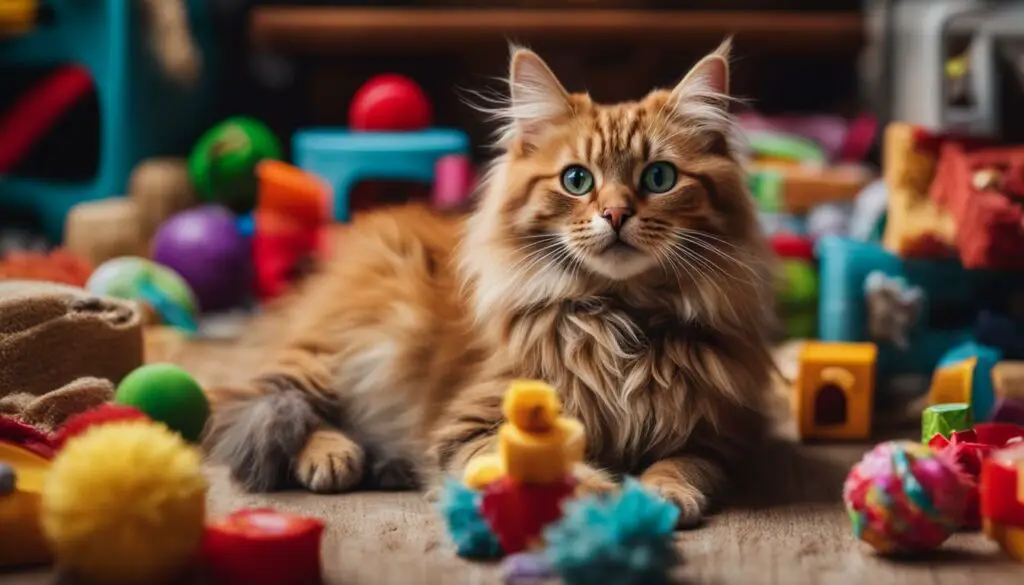As a cat owner, I know firsthand the playful and energetic nature of our feline friends. It seems like my cat always wants to play, whether it’s chasing toys, pouncing on imaginary prey, or simply batting at a dangling string. But have you ever wondered why cats are so playful? Let’s delve into the fascinating world of feline behavior and explore the joys of furry friendship.
- Cats are naturally playful and have a strong instinct for hunting and exploring.
- Playtime is essential for a cat’s mental and physical well-being.
- Feline companionship can provide additional play opportunities and help combat boredom and restlessness.
- Understanding your cat’s individual temperament and preferences is key to keeping them engaged and entertained.
- Regular play sessions with your cat can strengthen the bond between you and provide hours of joyful interaction.
Does Your Cat Need a Playmate?
If you have an active cat who always seems eager to play, you might be wondering if getting them a feline companion is a good idea. While not every cat needs a playmate, some cats can greatly benefit from having a companion to keep them entertained and engaged. Here are some signs that your cat may feel bored and could benefit from having a furry friend:
- Restlessness and agitation
- Decreased interest in exploring their environment
- Excessive meowing or attention-seeking behavior
- Destructive behavior, such as scratching furniture or excessive grooming
By getting another cat, you can provide your active feline with the extra attention and stimulation they need. A playmate can help alleviate boredom, provide entertainment, and keep your cat engaged both mentally and physically.
In addition, if your cat has recently lost a playmate, getting a new kitty could help them cope with the loss and provide them with companionship. However, it’s important to introduce new cats gradually and ensure they have compatible personalities to avoid conflicts and stress.
Remember, each cat is unique, and their individual needs and preferences should be considered when deciding if they would benefit from a companion. Observing your cat’s behavior and consulting with a veterinarian can help you make an informed decision about whether to get another cat.
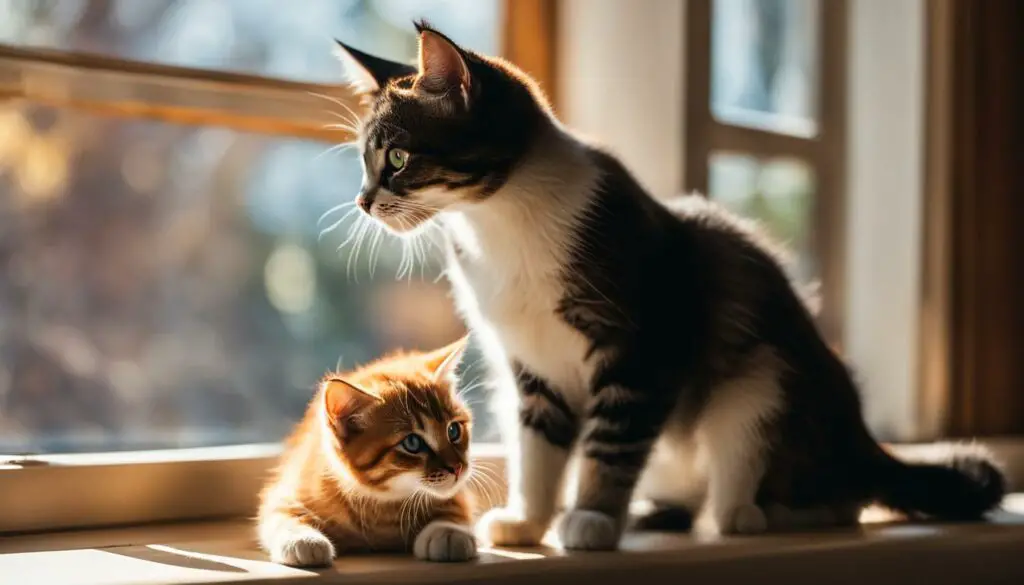
Benefits of Having a Cat Companion
Having a cat companion can have numerous benefits for both your active cat and your household. Some of the advantages include:
- Increased mental and physical stimulation: Two cats can engage in interactive play, providing each other with mental and physical exercise.
- Reduced boredom and loneliness: A cat companion can help alleviate boredom, reduce loneliness, and provide social interaction for your active cat.
- Improved pet’s mood: Having a feline friend can enhance your cat’s overall mood and well-being, reducing stress and anxiety.
- Promotes healthy behavior: Cats may learn from each other’s behavior, leading to better manners and improved litter box habits.
Before bringing another cat into your home, it’s essential to ensure you have the time, resources, and commitment to care for multiple pets. Introducing cats properly and providing a harmonious environment can enhance the chances of a successful companionship between your cats.
Don’t Get Another Cat If…
Before considering a new cat, it’s essential to take into account the feelings of your existing cat. Introducing a new feline companion into their territory can be a significant change, and it’s important to understand how they may react. Cats can be territorial creatures and may not always welcome a new addition with open paws. If your current cat shows signs of aggression or stress when encountering unfamiliar cats, it may not be the right time to bring another pet into the household.
Additionally, getting another cat requires time and attention. Cats thrive on human interaction and need regular playtime, grooming, and affection. If you don’t have the capacity to provide the necessary care and attention to multiple pets, it may be best to hold off on getting another cat. Cats are independent animals, but they still rely on their human companions for love and care.
Furthermore, consider the living space and resources available for each cat. Cats require their own territory, including enough space, litter boxes, food and water dishes, and resting areas. If your current living situation doesn’t provide adequate resources for multiple cats, it may be best to wait until you have a more suitable environment to accommodate another pet.
Table:
| Considerations | Existing Cat’s Feelings | Time and Attention | Living Space and Resources |
|---|---|---|---|
| Important Factor | Crucial | Essential | Key Aspect |
| Reaction to New Cat | Aggression or Stress | N/A | N/A |
| Availability for Interaction | N/A | Limited | N/A |
| Living Space Adaptability | N/A | N/A | Limited |
Remember, adding another cat to your household should be a decision made with careful consideration for the well-being and happiness of all involved. Take the time to assess your existing cat’s feelings, your ability to provide the necessary care and attention, and the suitability of your living space. By making an informed decision, you can create a harmonious environment for both you and your feline companions.

Choosing the Purr-fect Cat Companion
When considering getting a new cat as a companion for your existing pet, it’s important to take into account their temperament and age. Matching the right cat with your current pet can help ensure a harmonious and happy relationship. Here are some factors to consider:
Existing Pet’s Temperament
Take note of your current pet’s personality and behavior. If they are confident and sociable, they may be more open to having a new cat in their territory. On the other hand, if your pet is shy or nervous, it may be best to choose a cat with a more relaxed and gentle nature.
Age Difference
Consider the age of your existing pet when selecting a new cat. If you have a senior cat, they may not have the energy or patience to deal with a playful kitten. In this case, it’s better to choose a cat that is closer in age and activity level to your current pet.
Opposite Sex
When adding a new cat to your household, it’s generally recommended to choose a cat of the opposite sex. This can help reduce the likelihood of territorial disputes and aggression between the cats.
Confident Cat with a Slightly Shy Companion
Aim for a balance of personalities when selecting your new cat. It’s often beneficial to choose a confident cat as your existing pet’s companion, as they can help bring out the shyer cat’s confidence. A cat with a slightly shy nature can also help the more outgoing cat learn to be more considerate and gentle.
Remember, every cat is unique, and there are no guarantees that two cats will get along perfectly. However, taking these factors into consideration can increase the chances of a successful and enriching relationship between your cats.
Things Your New Cat Needs
When bringing a new cat into your home, it’s essential to create a space where they can feel safe and comfortable. Setting up a dedicated room for your new feline friend serves as their personal haven, providing them with a sense of security. This room should include all the necessities your cat needs to thrive.
The first item to consider is a litter box. Cats are naturally clean animals and need a designated area for their bathroom needs. Place the litter box in a quiet corner of the room, away from their food and water dishes. This promotes good hygiene and prevents any potential contamination.
In addition to the litter box, provide your new cat with dishes for food and water. These should be easily accessible and kept clean to ensure your furry friend stays well-nourished and hydrated. It’s recommended to use ceramic or stainless steel dishes, as they are durable and easy to clean.
| Items Your New Cat Needs: | |
|---|---|
| Litter Box | Place in a quiet corner of the dedicated room. |
| Dishes | Provide separate dishes for food and water, made of ceramic or stainless steel. |
| Toys | Include a variety of toys for mental and physical stimulation. |
| Collar and ID Tag | Ensure your cat can be easily identified if they were to ever wander off. |
| Microchip | An added layer of security in case your cat loses their collar or ID tag. |
Remember, your new cat’s dedicated room is their sanctuary. It should be a quiet and calming space where they can retreat and decompress. Adding comfortable bedding, such as a soft blanket or cat bed, will provide them with a cozy place to rest and recharge.
Aside from the essentials, it’s important to provide your new cat with toys to keep them mentally and physically stimulated. Toys help prevent boredom and encourage healthy exercise. Look for a variety of toys that cater to your cat’s natural instincts, such as scratching posts, interactive toys, and feather wands.
Finally, for added safety, consider outfitting your new cat with a collar and ID tag. This will ensure that they can be easily identified if they were to ever wander off. Additionally, microchipping your cat provides an extra layer of security, as the microchip contains your contact information and can be scanned by veterinarians or animal shelters.
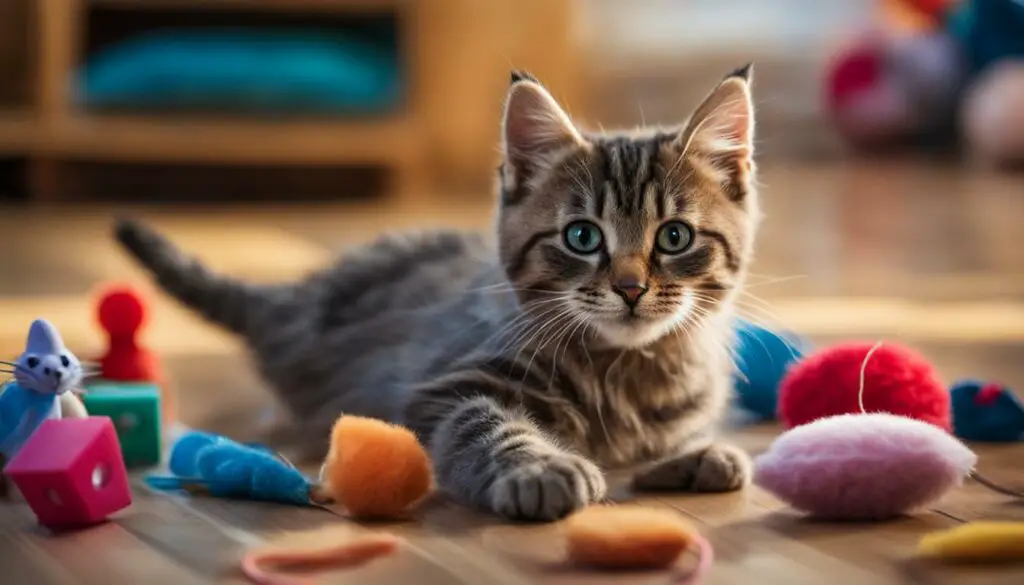
In conclusion, setting up a dedicated room with the necessary items for your new cat is crucial for their well-being and comfort. By providing a litter box, dishes, toys, a comfortable bed, and ensuring they have proper identification, you are creating a space where your new furry friend can thrive and feel secure.
Introducing Cats to Each Other
Introducing cats to each other can be a delicate process that requires patience and gradual introduction. It’s important to take things slow and allow the cats to get used to each other’s scents before they interact face-to-face. One effective method is scent sharing, where you exchange items, such as blankets or bedding, between the cats to help them become familiar with each other’s smells.
Another useful technique is feeding the cats on opposite sides of a closed door. This allows them to associate positive experiences, like mealtime, with each other’s presence. Gradually, you can increase the interaction by having supervised play sessions where they can interact under your careful watch.
Throughout the introduction process, it’s essential to provide ample love and attention to both cats. This will help them feel secure and reassured in their new dynamic. By following these steps, you can increase the chances of a successful and harmonious relationship between your furry friends.
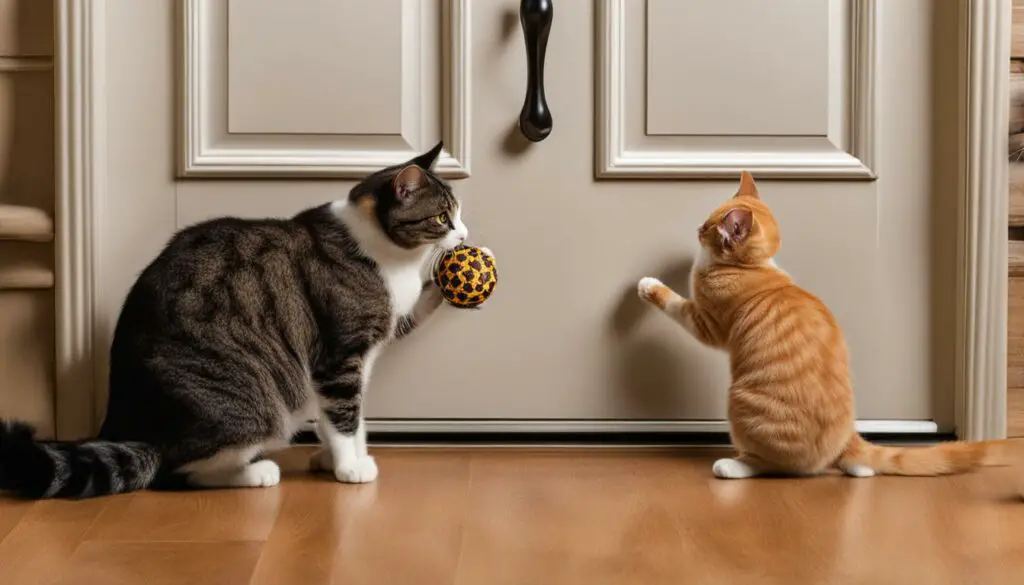
| Introducing Cats to Each Other: | Key Steps |
|---|---|
| Scent Sharing | Exchange items with the cats’ scents to familiarize them with each other. |
| Feeding on Opposite Sides of a Closed Door | Associate positive experiences, like mealtime, with each other’s presence. |
| Supervised Play Sessions | Allow the cats to interact under your careful watch. |
| Provide Love and Attention | Make sure both cats feel secure and reassured throughout the process. |
It’s Playtime!
After successfully introducing your cats and ensuring they are comfortable with each other’s presence, it’s time to engage in supervised play sessions. These play sessions are an important step in helping the cats get to know each other better and build a strong bond. During these sessions, it is crucial to monitor their interactions closely to ensure their safety and well-being.
Start the supervised play sessions in a neutral space where both cats feel comfortable. Use interactive toys, such as feather wands or crinkle balls, to engage both cats in play. Observe how they interact with each other and look for positive signs, such as play bows, gentle chasing, or taking turns with toys. These behaviors indicate that they are enjoying each other’s company and building a positive relationship.
However, it’s important to be vigilant and end the play sessions if any tension arises between the cats. Signs of tension may include hissing, growling, or aggressive behavior. Ending the session helps prevent conflicts and ensures the cats’ emotional and physical well-being. Remember, the goal is to create a harmonious environment for all cats involved.
Building a strong bond between your cats takes patient and persistent effort. It may take time for the cats to become fully comfortable with each other, so continue to engage in supervised play sessions regularly. Over time, the cats will learn to trust and enjoy each other’s company, leading to a harmonious and playful relationship.

Benefits of Supervised Play Sessions:
- Helps cats get to know each other better
- Builds a strong bond and positive relationship
- Provides mental and physical stimulation
- Reduces the risk of conflicts and aggression
How to Solve Unprovoked Aggressive Cat Behavior
If you’re dealing with unprovoked aggressive cat behavior, it’s important to understand the different types of aggression and how to address them. Cats can exhibit territorial aggression, fearful or defensive aggression, and even playful aggression. By implementing behavior modification techniques and ruling out any underlying health issues, you can help your aggressive cat become more relaxed and well-behaved.
Territorial aggression occurs when a cat feels threatened by the presence of another animal in its territory. This can lead to aggressive behavior such as hissing, growling, or even physical attacks. To address territorial aggression, provide separate spaces for each cat and gradually introduce them to each other using scent-sharing techniques. Additionally, create vertical spaces such as cat trees or shelves to give your cats their own territory.
Fearful or defensive aggression is often a response to a perceived threat or stressful situation. Cats may react with aggression when they are scared or feel cornered. To help alleviate this type of aggression, create a calm and secure environment for your cat. Provide hiding places and safe spaces where your cat can retreat to when feeling anxious. Avoid forcing your cat into uncomfortable situations and give them time to adjust and build trust.
Playful aggression is usually seen in kittens or young cats who are still learning appropriate play behavior. This type of aggression is often characterized by biting, scratching, and pouncing. To redirect this behavior, provide plenty of interactive toys and play with your cat using appropriate play techniques. Use positive reinforcement to reward calm behavior and discourage rough play.
Aggressive behavior in cats can be challenging, but with patience, consistency, and the right techniques, you can help your cat overcome their aggressive tendencies and create a harmonious environment in your home.
| Type of Aggression | Characteristics | Methods to Address |
|---|---|---|
| Territorial Aggression | Hissing, growling, physical attacks | Create separate spaces, gradual introductions, provide vertical spaces |
| Fearful or Defensive Aggression | Reacting to perceived threats or stressful situations | Create a calm environment, provide hiding places, allow time to adjust and build trust |
| Playful Aggression | Biting, scratching, pouncing during play | Provide interactive toys, redirect behavior, use positive reinforcement |
Remember, addressing aggressive cat behavior requires patience and a tailored approach for each individual cat. If your efforts to modify your cat’s behavior are not successful, it’s important to consult with a professional cat behaviorist or veterinarian who can provide further guidance and support.
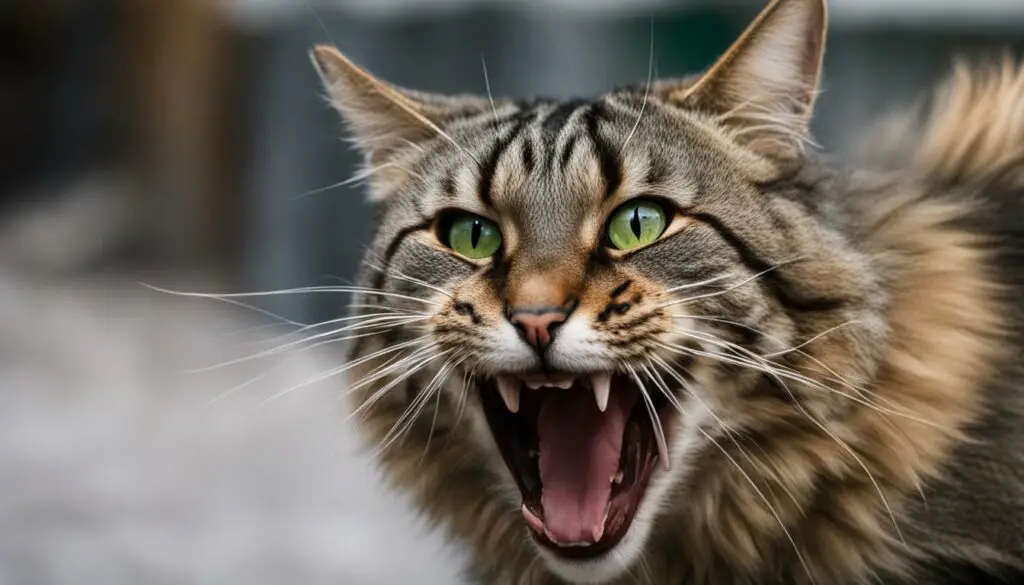
Behavior Modification Techniques
- Interrupt aggressive behavior: Use a loud noise or distraction to redirect your cat’s attention away from aggression.
- Reward calm behavior: Use positive reinforcement to reward your cat when they exhibit calm and non-aggressive behavior.
- Provide mental and physical stimulation: Engage your cat in regular play sessions and provide interactive toys to help them release pent-up energy.
- Establish a routine: Cats thrive on routine, so providing a structured daily schedule can help reduce stress and prevent aggression.
By implementing these behavior modification techniques and understanding the underlying reasons for your cat’s aggression, you can work towards resolving the issue and creating a peaceful and harmonious environment for both you and your feline friend.
Dealing with Aggressive Cat Behavior
Aggressive cat behavior can be challenging to handle, but there are steps you can take to create a peaceful household. One approach is to change the environment to reduce triggers and conflicts. Cats may become aggressive due to territorial issues, fear, or playfulness. By creating a calm and harmonious space for your cats, you can help alleviate some of the aggression.
If modifying the environment doesn’t resolve the aggression, seeking professional help is a viable option. A qualified cat behavior expert can provide guidance tailored to your specific situation. They can offer strategies and techniques to address the underlying causes of aggression and work towards a resolution.
Remember, dealing with aggressive cat behavior requires patience and persistence. It may take time to see improvements, but with the right interventions and professional assistance, you can create a peaceful household where your cats can coexist happily.
| Approach | Benefits |
|---|---|
| Changing the environment | Reduces triggers and conflicts |
| Seeking professional help | Expert guidance tailored to your situation |
| Creating a peaceful household | Promotes healthy coexistence among cats |
Dealing with aggressive cat behavior may seem overwhelming at times, but by taking these steps and seeking the right help, you can work towards a more harmonious living environment for both you and your feline companions.
Stuck On You? 6 Reasons Why Your CH Cat May Be Extra Clingy
If you have a CH cat, you may notice that they exhibit clingy behavior more often than other cats. CH, or cerebellar hypoplasia, is a condition that affects a cat’s coordination and balance. This can make them feel more vulnerable and in need of extra reassurance. Here are six possible reasons why your CH cat may be extra clingy:
- Nervousness: CH cats may feel more nervous or anxious due to their difficulty in movement. This can cause them to seek comfort and reassurance from their human companions.
- Insecurity: The challenges CH cats experience can make them feel insecure. They may cling to you for support and to feel safe.
- New Environment: If you recently adopted a CH cat or have moved to a new home, they may feel overwhelmed by the unfamiliar surroundings. Clinginess can be their way of seeking familiarity and stability.
- Trust Issues: Trust can be an issue for CH cats, especially if they have experienced trauma or neglect in the past. They may cling to you as a sign of trust and reliance.
- Health Issues: Clinginess in CH cats can also be a sign of underlying health issues. It’s essential to keep an eye out for any changes in their behavior or physical condition and consult with a veterinarian if necessary.
Understanding the reasons behind your CH cat’s clinginess can help you provide them with the care and support they need. Remember to shower them with love, patience, and attention, and create a safe and comfortable environment for them to thrive.
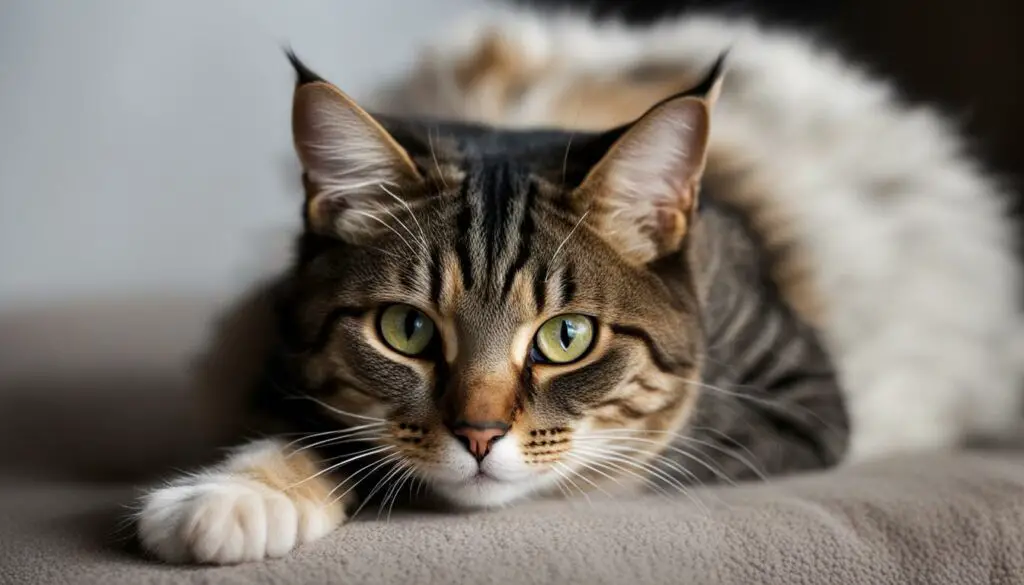
Testimonials:
“My CH cat, Luna, is always by my side. She depends on me for stability and support. I’ve learned to embrace her clinginess and cherish the unique bond we share.”
“Having a clingy CH cat can be challenging at times, but it’s also incredibly rewarding. My cat, Oliver, is my constant companion, and I wouldn’t have it any other way.”
| Reasons | Description |
|---|---|
| Nervousness | CH cats may feel more nervous or anxious due to their difficulty in movement. This can cause them to seek comfort and reassurance from their human companions. |
| Insecurity | The challenges CH cats experience can make them feel insecure. They may cling to you for support and to feel safe. |
| New Environment | If you recently adopted a CH cat or have moved to a new home, they may feel overwhelmed by the unfamiliar surroundings. Clinginess can be their way of seeking familiarity and stability. |
| Trust Issues | Trust can be an issue for CH cats, especially if they have experienced trauma or neglect in the past. They may cling to you as a sign of trust and reliance. |
| Health Issues | Clinginess in CH cats can also be a sign of underlying health issues. It’s essential to keep an eye out for any changes in their behavior or physical condition and consult with a veterinarian if necessary. |
Remember that each CH cat is unique, and their clinginess may vary. Providing them with love, patience, and a supportive environment will help them feel secure and cherished.
Clingy or Demanding?
When it comes to cats seeking attention, there are two distinct types: clingy cats and demanding cats. Clingy cats are often looking for comfort and support, and they may exhibit dependent behaviors such as following you around the house or always wanting to cuddle. On the other hand, demanding cats are more assertive in their quest for attention. They may meow incessantly or try to dominate other pets or family members to get what they want.
Understanding whether your cat is clingy or demanding is important for nurturing a healthy and balanced relationship. Clingy cats require gentle reassurance and a sense of security, while demanding cats need clear boundaries and consistent training. With a little patience and understanding, you can establish a harmonious dynamic with your feline friend.
To better understand the difference between clingy and demanding cats, let’s take a closer look at their behaviors:
| Clingy Cats | Demanding Cats |
|---|---|
| Behavior: | Behavior: |
| Follow you around the house | Meow excessively |
| Always want cuddles and attention | Try to dominate other pets or family members |
| Seek comfort and support | Insist on getting what they want |
When dealing with a clingy cat, it’s important to provide them with the comfort and support they seek. Take the time to give them attention and affection, while also respecting their need for personal space. Creating a calm and secure environment can help alleviate their clinginess and strengthen your bond.
On the other hand, demanding cats require a different approach. It’s crucial to set clear boundaries and establish a training routine that reinforces positive behavior. Redirect their attention to appropriate activities and reward them for calm and respectful behavior. By consistently reinforcing these boundaries, you can help your demanding cat understand their place in the household.
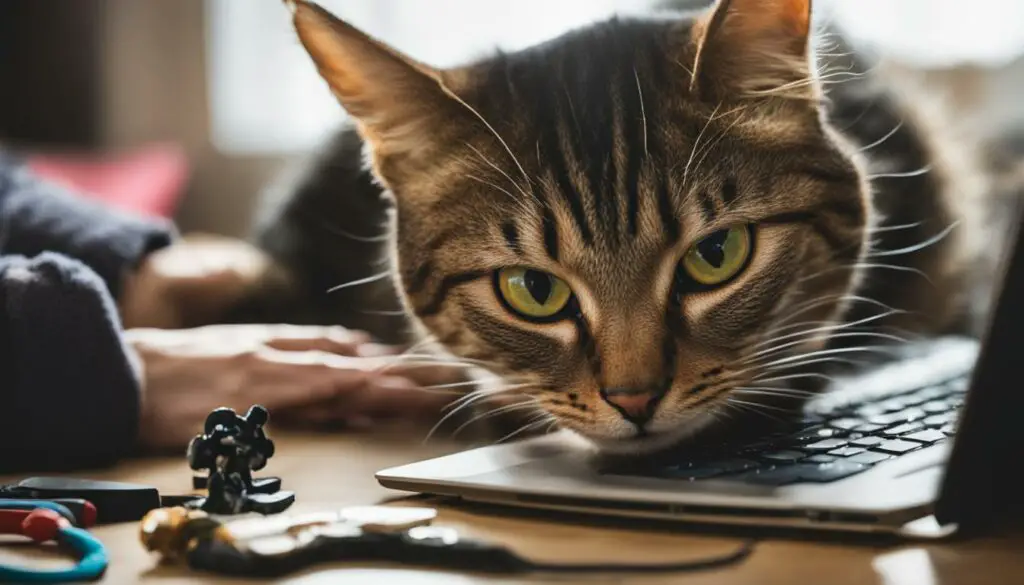
Summary
Differentiating between clingy and demanding cats is essential for building a strong and balanced relationship. Clingy cats seek comfort and support, while demanding cats are more assertive in their quest for attention. By understanding their behaviors and providing appropriate responses, you can create a loving and harmonious environment for both you and your feline companion.
Improving Your Relationship with Your Cat
Building a strong bond with your cat is essential for a happy and fulfilling relationship. By understanding your cat’s needs and providing them with the right balance of attention and affection, you can create a loving and trusting connection. Setting boundaries and establishing clear communication will also contribute to a harmonious household.
Understanding Your Cat’s Needs
Cats have unique needs and preferences, and it’s crucial to understand them to improve your relationship. Pay attention to your cat’s body language, vocalizations, and behavior to gauge their emotions and desires. Some cats may prefer quiet and solitude, while others thrive on social interaction and play. By observing and learning your cat’s individual personality, you can better meet their needs.
Providing Attention and Affection
Cats thrive on attention and affection from their human companions. Take time each day to engage in interactive play sessions, grooming, and cuddling. Use toys, such as feather wands or laser pointers, to stimulate your cat’s natural hunting instincts. Incorporate positive reinforcement, such as treats or praise, to reward and motivate desired behaviors. Regularly expressing your love and affection will strengthen the bond between you and your cat.
Setting Boundaries
While cats crave attention, it’s essential to establish boundaries to ensure a respectful and balanced relationship. Teach your cat appropriate behavior by discouraging unwanted actions, such as scratching furniture or jumping on countertops. Use gentle redirection and positive reinforcement to guide your cat towards desired behaviors. Providing a consistent routine, including designated play and meal times, will also help your cat feel secure and understand expectations.
| Benefits of Improving Your Relationship with Your Cat |
|---|
| Stronger bond and increased trust |
| Reduced stress and anxiety for both you and your cat |
| Enhanced overall well-being and happiness |
| Improved communication and understanding |
| Decreased likelihood of behavior problems |
By investing time and effort into improving your relationship with your cat, you will create a loving and harmonious environment where both of you can thrive. Remember to be patient, as building a strong bond takes time and understanding. With the right balance of attention, affection, and boundaries, your cat will feel loved and secure, resulting in a joyful and fulfilling relationship.
Benefits of Playtime for Cats
Playtime is an essential part of a cat’s daily routine, providing both mental and physical stimulation. Engaging in play with your cat has numerous benefits that contribute to their overall well-being and happiness. Here are some key advantages of incorporating regular playtime into your furry friend’s schedule:
- Bonding with your cat: Playtime allows you to strengthen your bond with your cat. By participating in interactive play sessions, you create positive associations and shared experiences, fostering a deeper connection between you and your feline companion.
- Mental and physical stimulation: Playtime keeps your cat mentally agile and physically active. Interactive toys and games help stimulate their instinctual behaviors, such as stalking, pouncing, and chasing, which provides both mental and physical exercise.
- Reducing behavior issues: Regular play sessions can help reduce behavior issues in cats. By providing an outlet for their energy and natural instincts, playtime helps prevent boredom, frustration, and destructive behaviors such as scratching furniture or excessive meowing.
It is crucial to choose appropriate toys and play techniques based on your cat’s preferences and abilities. Some cats enjoy chasing feather wands or laser pointers, while others prefer puzzle toys or interactive treat dispensers. Discover what activities and toys your cat responds to best and incorporate them into your playtime routine. Remember to always supervise play sessions and provide a safe environment for your cat to play in.
Incorporating regular playtime into your cat’s daily routine is a fantastic way to enhance their overall quality of life. Not only does it provide them with mental and physical stimulation, but it also promotes a stronger bond between you and your feline companion. So grab a toy and spend some quality playtime with your cat today!
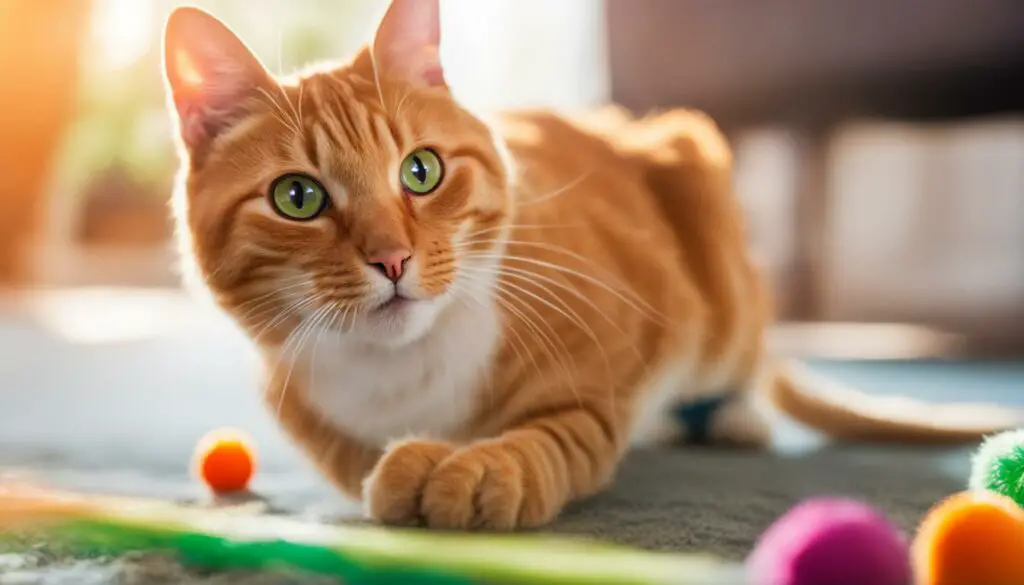
The Power of Play in Feline Relationships
Play is an essential component in fostering strong and harmonious relationships among cats. Not only does playtime provide mental and physical stimulation, but it also enhances social bonds, reduces conflicts, and promotes exercise. When cats engage in play together, they establish a common language and develop trust, leading to a happier and more connected feline community.
Playing helps cats communicate and understand each other’s boundaries. Through interactive play, cats learn to establish appropriate play behaviors and recognize when their playmate has had enough. This reduces the likelihood of conflicts and aggressive behaviors, creating a more peaceful environment for all cats involved.
Regular play sessions also promote exercise, which is crucial for a cat’s overall well-being. Play helps cats burn off excess energy, maintain a healthy weight, and prevent boredom-related behaviors. By providing ample opportunities for play, cat owners can ensure their feline friends are physically active and mentally stimulated.
| Benefits of Play in Feline Relationships |
|---|
| Enhances social bonds among cats |
| Reduces conflicts and aggressive behaviors |
| Promotes exercise and physical well-being |
To encourage play in feline relationships, provide a variety of toys and interactive activities that cater to different play styles. Some cats may prefer chasing toys, while others may enjoy pouncing or wrestling. Experiment with different toys and observe your cats’ preferences to find what engages them the most.
It’s important to supervise play sessions, especially when introducing new cats or kittens to the household. This ensures that play remains fun and safe for all involved. If any conflicts or tensions arise during play, redirect the cats’ attention to a different toy or activity to diffuse the situation.
Remember, play is not just a leisure activity for cats but an essential aspect of their socialization and well-being. By fostering a playful atmosphere and encouraging positive interactions, you can strengthen the bonds between your feline companions and create a harmonious cat community.
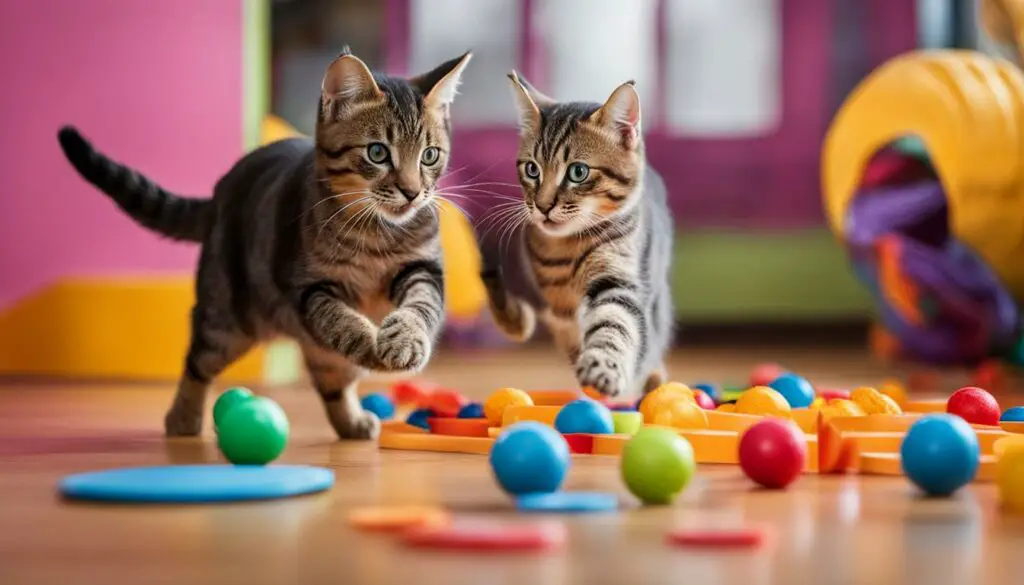
References:
- “The Importance of Play for Cats” – International Cat Care
- “The Role of Play in the Development of Social Bonds in Kittens” – Journal of Veterinary Behavior
- “The Benefits of Play for Cats” – American Association of Feline Practitioners
Conclusion
In conclusion, understanding the needs of your cat is essential in building a strong bond. A key aspect of this is providing ample playtime for your feline friend. Engaging in regular play sessions not only offers mental and physical stimulation but also strengthens the relationship between you and your cat.
To make playtime enjoyable for both you and your cat, consider a few tips. First, use interactive toys, such as feather wands or puzzle toys, to keep your cat engaged and entertained. Second, vary the play routine to prevent boredom, incorporating different types of play, such as chasing, pouncing, and batting. Third, prioritize quality over quantity, focusing on shorter play sessions that capture your cat’s full attention.
Additionally, remember that building a strong bond goes beyond playtime. Show your cat attention and affection daily, whether it’s through gentle petting, grooming, or cuddling. Setting boundaries and providing a safe and comfortable environment also contribute to a healthy relationship.
In summary, by dedicating time for play, giving attention and affection, and creating a nurturing environment, you can build a strong bond with your cat that will bring both of you joy and companionship for years to come.
FAQ
Does my cat need a playmate?
Not every cat needs a playmate, but if your cat loves to play and is active, getting another cat can provide extra attention and be a good solution. If your cat lost a playmate recently, a new kitty could help them deal with the loss. Signs that your cat may benefit from a companion include boredom, restlessness, agitation, and decreased interest in exploring.
What should I consider before getting another cat?
Before getting another cat, make sure you have the time and attention to give to another pet. Consider your existing cat’s feelings about having a new feline friend in the home. It’s important to recognize how your current cat may react to a new cat sharing their space and make a decision accordingly.
How do I choose the right cat companion?
When choosing a new cat, consider your existing pet’s temperament and age. If you have a senior cat, getting a playful kitten may not be the best option. It’s generally recommended to choose a cat of the opposite sex. Consider the balance of personalities between the cats, aiming for a confident cat with a slightly shy companion.
What does my new cat need?
Your new cat needs a dedicated space where they can feel safe and have their own belongings. Provide a litter box, dishes, toys, and a comfortable bed. If your cats eventually use a shared litter box, choose one designed for multiple cats. Consider getting your cats collars with ID tags and consider microchipping them for added safety.
How do I introduce cats to each other?
Introducing cats to each other should be done gradually and carefully. Start by sharing scents through items that have the other cat’s scent. Then, feed the cats on opposite sides of a closed door to associate positive experiences with each other’s presence. Slowly increase the interaction by allowing supervised play sessions. Provide ample love and attention to both cats throughout the process.
What should I do if my cat displays aggressive behavior?
Understanding the types of aggressive cat behavior is crucial in addressing the issue. Cats can show territorial aggression, fearful or defensive aggression, or playful aggression. Behavior modification techniques, such as interrupting aggressive behavior and offering rewards for calm behavior, can be effective in addressing certain types of aggression. It’s important to rule out any underlying health issues that may be causing the aggression.
How can I improve my relationship with my cat?
Building a strong bond with your cat involves understanding their needs and providing them with attention and affection. Setting boundaries and training them to respect personal space can help improve the relationship. Regular playtime, grooming, and positive reinforcement can strengthen the bond between you and your cat.
Why is playtime important for cats?
Playtime is essential for cats as it provides mental and physical stimulation. Engaging in play with your cat strengthens the bond between you and can help reduce behavior issues. Use interactive toys, catnip, and other forms of entertainment to keep your cat engaged and entertained.
How does play affect feline relationships?
Play not only enhances social bonds between cats but also reduces conflicts and aggression. It promotes exercise and physical well-being for both individual cats and those in a multi-cat household. Encouraging play among multiple cats can create a harmonious and playful atmosphere in your home.
What if my CH cat is extra clingy?
Some CH cats may exhibit clingy behavior due to feelings of nervousness and insecurity. Changes in the environment, being new to a household, and bonding complications may contribute to clinginess. Health issues should also be considered if clingy behavior develops suddenly. Understanding the reasons behind clinginess can help improve the relationship with your CH cat.
How do I differentiate between clingy and demanding cats?
Clingy cats seek comfort and support and may exhibit dependent behaviors. Demanding cats are more assertive and may meow or dominate to get what they want. Recognizing the behavior and training the relationship accordingly can improve the dynamics with your cat.

